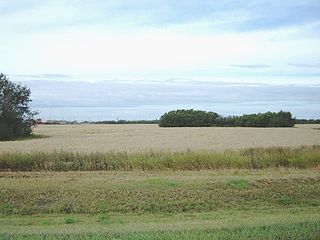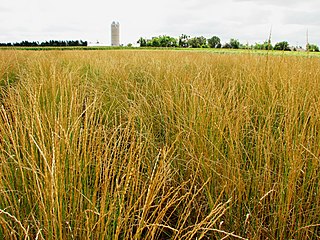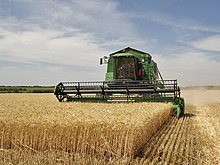The following outline is provided as an overview of and topical guide to agriculture:

Conservation agriculture (CA) can be defined by a statement given by the Food and Agriculture Organization of the United Nations as "Conservation Agriculture (CA) is a farming system that can prevent losses of arable land while regenerating degraded lands.It promotes minimum soil disturbance, maintenance of a permanent soil cover, and diversification of plant species. It enhances biodiversity and natural biological processes above and below the ground surface, which contribute to increased water and nutrient use efficiency and to improved and sustained crop production."

The modern combine harvester, simply combine, is a machine designed to harvest a variety of cultivated seeds. Combine harvesters are one of the most economically important labour-saving inventions, significantly reducing the fraction of the population engaged in agriculture. Among the crops harvested with a combine are wheat, rice, oats, rye, barley, corn (maize), sorghum, millet, soybeans, flax (linseed), sunflowers and rapeseed. The separated straw is then either chopped onto the field and ploughed back in, or laid out in rows, ready to be baled and used for bedding and cattle feed.

A reaper is a farm implement or person that reaps crops at harvest when they are ripe. Usually the crop involved is a cereal grass. The first documented reaping machines were Gallic reapers that were used in Roman times in what would become modern-day France. The Gallic reaper involved a comb which collected the heads, with an operator knocking the grain into a box for later threshing.

A sickle, bagging hook, reaping-hook or grasshook is a single-handed agricultural tool designed with variously curved blades and typically used for harvesting or reaping grain crops, or cutting succulent forage chiefly for feeding livestock. Falx was a synonym but was later used to mean any of a number of tools that had a curved blade that was sharp on the inside edge such as a scythe.

Panicum virgatum, commonly known as switchgrass, is a perennial warm season bunchgrass native to North America, where it occurs naturally from 55°N latitude in Canada southwards into the United States and Mexico. Switchgrass is one of the dominant species of the central North American tallgrass prairie and can be found in remnant prairies, in native grass pastures, and naturalized along roadsides. It is used primarily for soil conservation, forage production, game cover, as an ornamental grass, in phytoremediation projects, fiber, electricity, heat production, for biosequestration of atmospheric carbon dioxide, and more recently as a biomass crop for ethanol and butanol.

Corn stover consists of the leaves, stalks, and cobs of maize (corn) plants left in a field after harvest. Such stover makes up about half of the yield of a corn crop and is similar to straw from other cereal grasses; in Britain it is sometimes called corn straw. Corn stover is a very common agricultural product in areas of large amounts of corn production. As well as the non-grain part of harvested corn, the stover can also contain other weeds and grasses. Field corn and sweet corn, two different types of maize, have relatively similar corn stover.

Energy crops are low-cost and low-maintenance crops grown solely for renewable bioenergy production. The crops are processed into solid, liquid or gaseous fuels, such as pellets, bioethanol or biogas. The fuels are burned to generate electrical power or heat.

Themeda triandra is a species of C4 perennial tussock-forming grass widespread in Africa, Australia, Asia and the Pacific. In Australia it is commonly known as kangaroo grass and in East Africa and South Africa it is known as red grass and red oat grass or as rooigras in Afrikaans. Kangaroo grass was formerly thought to be one of two species, and was named Themeda australis.

Agriculture in Saskatchewan is the production of various food, feed, or fiber commodities to fulfill domestic and international human and animal sustenance needs. The newest agricultural economy to be developed in renewable biofuel production or agricultural biomass which is marketed as ethanol or biodiesel. Plant cultivation and livestock production have abandoned subsistence agricultural practices in favor of intensive technological farming resulting in cash crops which contribute to the economy of Saskatchewan. The particular commodity produced is dependent upon its particular biogeography or ecozone of Geography of Saskatchewan. Agricultural techniques and activities have evolved over the years. The first nation nomadic hunter-gatherer lifestyle and the early immigrant ox and plow farmer proving up on his quarter section of land in no way resemble the present farmer operating huge amounts of land or livestock with their attendant technological mechanization. Challenges to the future of Saskatchewan agriculture include developing sustainable water management strategies for a cyclical drought prone climate in south western Saskatchewan, updating dryland farming techniques, stabilizing organic definitions or protocols and the decision to grow, or not to grow genetically modified foods. Domestically and internationally, some commodities have faced increased scrutiny from disease and the ensuing marketing issues.

Intensive crop farming is a modern industrialized form of crop farming. Intensive crop farming's methods include innovation in agricultural machinery, farming methods, genetic engineering technology, techniques for achieving economies of scale in production, the creation of new markets for consumption, patent protection of genetic information, and global trade. These methods are widespread in developed nations.
During the Sangam age, 500 BCE – 300 CE, agriculture was the main vocation of the Tamil. It was considered a necessity for life, and hence was treated as the foremost among all occupations. The farmers or the Ulavar were placed right at the top of the social classification. As they were the producers of food grains, they lived with self-respect. Agriculture during the early stages of Sangam period was primitive, but it progressively got more efficient with improvements in irrigation, ploughing, manuring, storage and distribution. The ancient Tamils were aware of the different varieties of soil, the kinds of crops that can be grown on them and the various irrigation schemes suitable for a given region. These were also in Madras, Thanjore.

For millennia, agriculture has played an important role in the Chinese economy and society. By the time the People's Republic of China was established in 1949, virtually all arable land was under cultivation; irrigation and drainage systems constructed centuries earlier and intensive farming practices already produced relatively high yields. But little prime virgin land was available to support population growth and economic development. However, after a decline in production as a result of the Great Leap Forward (1958–60), agricultural reforms implemented in the 1980s increased yields and promised even greater future production from existing cultivated land.

Thinopyrum intermedium, known commonly as intermediate wheatgrass, is a sod-forming perennial grass in the Triticeae tribe of Pooideae native to Europe and Western Asia. It is part of a group of plants commonly called wheatgrasses because of the similarity of their seed heads or ears to common wheat. However, wheatgrasses generally are perennial, while wheat is an annual. It has gained the Royal Horticultural Society's Award of Garden Merit as an ornamental.

Agricultural machinery relates to the mechanical structures and devices used in farming or other agriculture. There are many types of such equipment, from hand tools and power tools to tractors and the countless kinds of farm implements that they tow or operate. Diverse arrays of equipment are used in both organic and nonorganic farming. Especially since the advent of mechanised agriculture, agricultural machinery is an indispensable part of how the world is fed. Agricultural machinery can be regarded as part of wider agricultural automation technologies, which includes the more advanced digital equipment and robotics. While agricultural robots have the potential to automate the three key steps involved in any agricultural operation, conventional motorized machinery is used principally to automate only the performing step where diagnosis and decision-making are conducted by humans based on observations and experience.
Indigenous horticulture is practised in various ways across all inhabited continents. Indigenous refers to the native peoples of a given area and horticulture is the practice of small-scale intercropping.

The production of corn plays a major role in the economy of the United States. The US is the largest corn producer in the world, with 96,000,000 acres (39,000,000 ha) of land reserved for corn production. Corn growth is dominated by west/north central Iowa and east central Illinois. Approximately 13% of its annual yield is exported.

Agriculture in the Middle Ages describes the farming practices, crops, technology, and agricultural society and economy of Europe from the fall of the Western Roman Empire in 476 to approximately 1500. The Middle Ages are sometimes called the Medieval Age or Period. The Middle Ages are also divided into the Early, High, and Late Middle Ages. The early modern period followed the Middle Ages.
This glossary of agriculture is a list of definitions of terms and concepts used in agriculture, its sub-disciplines, and related fields, including horticulture, animal husbandry, agribusiness, and agricultural policy. For other glossaries relevant to agricultural science, see Glossary of biology, Glossary of ecology, Glossary of environmental science, and Glossary of botanical terms.




















